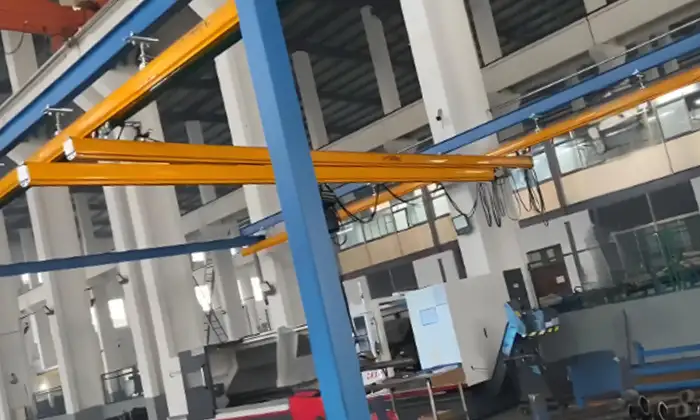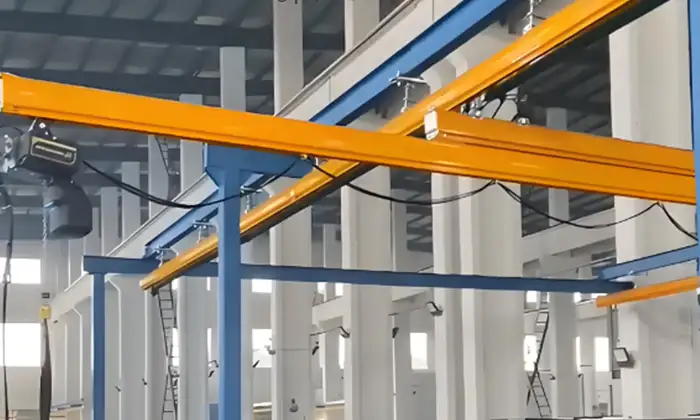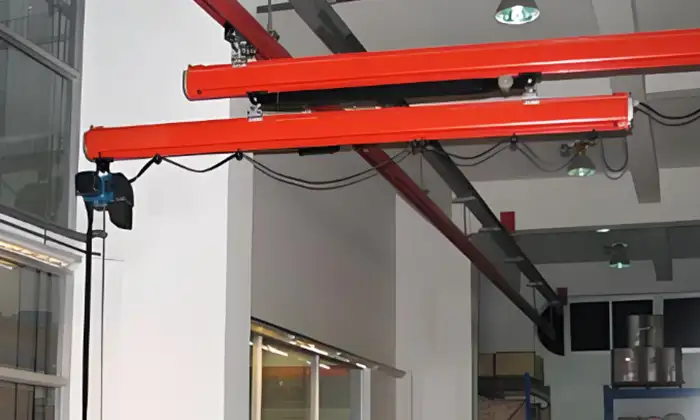Streamline material handling and save space in small workshops with the versatile, extendable design of KBK cranes.
Telescoping KBK Cranes
Telescoping KBK cranes are compact, flexible lifting systems designed for small workshops and tight spaces. These cranes use a modular system that can be customized to fit various needs. The key feature is their telescoping beam, which extends and retracts, allowing operators to reach difficult areas without taking up too much space. This makes them ideal for environments where traditional cranes are too large or impractical.
Key Features of KBK Cranes
KBK cranes are lightweight, modular overhead cranes that can be easily adjusted or expanded. They are known for their:
- Modular design: Easy to reconfigure for different tasks or spaces.
- Lightweight components: Making installation and operation simpler.
- Versatile capacity: Often available in 1-ton and 2-ton options, perfect for smaller loads.
- Smooth operation: Designed for efficiency with low maintenance.
Significance of Telescoping Functionality in Small Workshops
In small workshops or confined spaces, space is limited, and the ability to reach different areas is crucial. The telescoping feature allows the crane’s beam to extend when needed, providing access to hard-to-reach spots without occupying more space. This flexibility helps improve productivity in tight environments, like narrow aisles or small production lines, where traditional cranes might be too bulky.
Telescoping KBK Cranes in Small Workshops
Material Handling in Confined Spaces
Small workshops or production lines often face challenges when it comes to material handling due to space constraints. Traditional cranes or lifting systems can be too bulky for tight areas, making it difficult to move materials efficiently. This can lead to delays and disrupt the flow of operations.
Telescoping KBK cranes address these challenges by providing a compact, flexible lifting solution. The extendable beams allow the crane to reach areas that would otherwise be difficult to access, all while keeping the footprint small.
- Compact design: Takes up minimal space, making it ideal for tight workshop layouts.
- Extended reach: The telescoping function allows the beam to extend and retract, providing access to hard-to-reach areas.
- Efficient material handling: The crane can move materials in narrow aisles and around obstacles without blocking other workstations or pathways.
Optimizing Workflow in Limited Spaces
In small workshops, space is a precious commodity, and every inch counts. Telescoping KBK cranes are designed to maximize workspace efficiency without sacrificing performance. Their flexible, modular design ensures they can be adapted to fit a variety of workshop layouts.
- Space-saving design: The crane's compact size and modular components allow it to fit into tight spaces and be reconfigured as needed.
- Increased flexibility: The telescoping beam offers adjustable reach, so it can handle tasks at different points in the workspace without requiring a large crane.
- Improved accessibility: The crane can access elevated or hard-to-reach areas that might be obstructed by other equipment, helping maintain smooth workflow.
By optimizing space usage and providing flexibility, telescoping KBK cranes improve workflow efficiency in small workshops. Workers can complete lifting tasks more quickly and safely, minimizing delays and maximizing productivity.

Key Advantages of Telescoping KBK Cranes
Space Efficiency
The telescoping feature of KBK cranes is a game-changer when it comes to space management in small workshops. This adjustable beam allows the crane to extend and retract as needed, providing access to areas that may be hard to reach with fixed or larger overhead cranes.
- Access to hard-to-reach areas: The extendable beam lets the crane reach different parts of the workshop without needing more space or large structural changes.
- Conserving floor space: By reducing the need for large, stationary cranes, telescoping KBK cranes free up valuable floor space, allowing workers to move around freely and maintain a clear, efficient workspace.
Increased Maneuverability
One of the biggest benefits of telescoping KBK cranes is their ability to maneuver in narrow, confined spaces. The flexible design and smooth operating mechanisms make it easy to adjust the crane's position quickly and efficiently.
- Work in narrow aisles and tight zones: The compact size of the crane and the adjustable beam allow it to work in areas where other cranes would be too bulky or inefficient.
- Smooth extension and retraction: The easy-to-use extension mechanism allows operators to quickly adjust the crane’s reach, improving workflow and reducing time spent adjusting equipment.
Lightweight Load Handling
Telescoping KBK cranes are ideal for handling smaller, lighter loads, typically in the 1-ton to 2-ton range. These lighter cranes are perfect for frequent lifting tasks in workshops where larger equipment is unnecessary and impractical.
- Ideal for 1-ton and 2-ton capacities: These cranes are designed to handle smaller loads, making them perfect for lighter lifting tasks without needing more power or space.
- Reduced wear on infrastructure: Because they are lightweight, these cranes put less stress on the building structure, helping to preserve the integrity of the workshop’s floor and ceiling while performing frequent lifting tasks.
These key advantages—space efficiency, maneuverability, and lightweight handling—make telescoping KBK cranes an ideal choice for small workshops looking to improve their material handling processes without compromising on space or performance.
Applications of Telescoping KBK Cranes in Small Workshops
Typical Tasks and Uses
Telescoping KBK cranes are highly versatile and well-suited for a variety of tasks in small workshops. Their compact size and extendable beam make them ideal for lifting and moving materials in tight, crowded environments.
- Lifting lightweight components, tools, or machinery parts: These cranes are perfect for lifting smaller items such as tools, machine parts, or lightweight components that need to be moved between workstations or storage areas.
- Transporting materials along production lines or assembly points: The crane's ability to extend and retract means it can transport materials along narrow production lines, allowing operators to move items with ease while avoiding congestion or obstruction in the workspace.
Customization for Specific Workshop Needs
One of the standout features of telescoping KBK cranes is their adaptability. The adjustable beam length and modular design allow them to be tailored to specific needs, making them highly customizable for different workshop layouts.
- Adjustable beam lengths: The telescoping feature lets operators change the crane’s reach depending on the task, allowing it to lift materials from a variety of angles and positions in a small workshop.
- Tailored configurations: The modular components of the crane system can be rearranged to suit the unique layout of any workshop, ensuring that the crane is used most efficiently in the available space. This customization helps maximize workspace while ensuring the crane meets the specific lifting needs of the operation.
By offering flexibility in both design and function, telescoping KBK cranes can be adapted to suit a wide range of tasks and environments in small workshops, improving material handling efficiency and productivity.

How Telescoping KBK Cranes Improve Operational Efficiency
Boosting Productivity in Tight Spaces
Telescoping KBK cranes are designed to enhance productivity, especially in small or congested workshops where space is limited. The ability to quickly adjust the crane’s reach and move materials efficiently helps reduce operational delays and improve workflow.
- Faster cycle times: The smooth extension and retraction of the crane allow operators to make quick adjustments, moving materials between workstations or production areas faster and more efficiently.
- Reduced downtime: These cranes are easy to operate and maintain, which leads to fewer breakdowns and less downtime. With fewer maintenance requirements, they keep your workshop running smoothly and help maintain high productivity levels.
Cost-Effective Operations
Telescoping KBK cranes offer a cost-effective alternative to larger, more complex lifting systems. Their lightweight design and adaptability make them an affordable option for small workshops looking to optimize their material handling processes without significant investment.
- Lower investment costs: Compared to larger overhead cranes or more complex systems, telescoping KBK cranes have a lower initial investment cost. This makes them a great choice for workshops on a budget that still need reliable and efficient lifting solutions.
- Consolidating tasks: With the ability to handle a variety of tasks, from lifting to transporting materials, these cranes reduce the need for multiple lifting devices. This not only cuts down on equipment costs but also saves valuable space and improves overall operational efficiency.
By increasing productivity and reducing costs, telescoping KBK cranes help small workshops streamline their operations and maximize their resources, making them a smart, cost-effective investment.
Safety and Maintenance Considerations
Ensuring Safe Operation in Confined Areas
Safety is a critical aspect when using telescoping KBK cranes in small workshops. Due to the compact nature of these cranes and their ability to operate in confined spaces, following proper safety protocols is essential to prevent accidents and ensure smooth operations.
- Key safety protocols: Operators should always follow standard lifting practices, such as ensuring the crane’s load capacity is not exceeded and the load is properly secured before lifting. Additionally, the workshop area should be clear of unnecessary obstacles to avoid collisions during operation.
- Ergonomic considerations: Telescoping KBK cranes should be used in a way that minimizes operator strain. Adjustable controls, proper positioning of the crane, and ensuring that operators have sufficient space to maneuver the controls help reduce the risk of injury from overreaching or awkward body positions during operation.
Maintenance Best Practices
Regular maintenance is key to keeping telescoping KBK cranes in optimal working condition. Proper care ensures the crane operates smoothly, extends its lifespan, and avoids unexpected breakdowns.
- Routine checks for beam extension and retraction functionality: The telescoping beam mechanism should be inspected regularly for any signs of wear or malfunction. Ensuring smooth operation of the extension and retraction function is vital to maintaining the crane’s performance and preventing accidents.
- Keeping the crane system clean: Dirt, debris, and grime can interfere with the smooth operation of the crane’s components. Regularly cleaning the crane and ensuring that all parts, especially the telescoping mechanism, are free from obstructions will help prevent wear and tear and maintain its efficiency.
By following these safety protocols and maintenance best practices, small workshops can ensure their telescoping KBK cranes continue to operate safely, efficiently, and with minimal downtime. Regular care and attention to safety can significantly enhance the longevity and performance of the crane while protecting workers and the workplace.
Case Studies
Real-World Examples of Telescoping KBK Cranes in Small Workshops
Telescoping KBK cranes are already helping many small workshops and production environments improve their material handling operations. Below are two real-world examples that highlight the practical applications and benefits of these cranes.
Case Study 1: A Small Manufacturing Plant Utilizing a 2-Ton Telescoping Crane for Frequent Lifting Tasks
A small manufacturing plant specializing in the production of electronic components faced challenges with material handling in their compact workshop. They were using a traditional lifting system, but the large crane was taking up too much space and was difficult to maneuver around tight work areas.
After installing a 2-ton telescoping KBK crane, the plant experienced a significant boost in efficiency. The crane's ability to extend and retract allowed operators to easily reach materials stored in hard-to-access areas without having to move large equipment around the workshop. The 2-ton capacity was perfect for handling the small, lightweight components commonly used in their production process. The result was faster lifting cycles, reduced downtime, and more available floor space for other tasks, ultimately improving overall productivity.
Case Study 2: A Production Line in a Confined Space Benefitting from the Compact Size and Extendable Beams
A production line operating in a narrow, confined space needed a crane that could provide efficient material handling without taking up too much room. Traditional overhead cranes were too large and cumbersome for the workspace, making it challenging to move materials across the line efficiently.
By installing a telescoping KBK crane with a 1-ton lifting capacity, the production team was able to streamline their operations. The compact crane fit perfectly within the limited floor area, and the extendable beam made it easy to transport materials between workstations, even in the tightest corners. The flexibility of the crane allowed it to be adjusted to various tasks throughout the day, improving the speed of production and reducing the time spent on material handling. The result was a safer, more efficient production environment with less congestion and higher throughput.
These case studies demonstrate the effectiveness of telescoping KBK cranes in small workshops and production lines. Whether for frequent lifting tasks or working in tight spaces, these cranes offer a versatile and efficient solution for improving material handling and boosting overall productivity.
Conclusion
Telescoping KBK cranes offer a range of advantages for small workshops, making them an excellent solution for improving material handling in confined spaces. The key benefits include:
- Space efficiency: Their compact design and extendable beams allow these cranes to work in tight areas, maximizing available floor space.
- Increased maneuverability: The crane’s ability to adjust its reach with ease allows for smooth operation in narrow aisles and congested environments.
- Productivity boost: With faster cycle times, minimal downtime, and the ability to handle lightweight loads efficiently, telescoping KBK cranes help streamline operations, keeping your workshop running at peak efficiency.
For small-scale operations that need a lightweight, adaptable lifting solution, telescoping KBK cranes present a smart investment. Their flexibility, combined with their space-saving design, allows them to fit seamlessly into even the most confined workshops. By improving workflow, reducing clutter, and enhancing productivity, these cranes can help optimize your operations while minimizing space and cost concerns.
If you're looking to maximize your workshop’s efficiency and ensure smooth, safe material handling, consider incorporating a telescoping KBK crane. With their proven benefits and ease of use, these cranes can make a significant impact on your daily operations.




